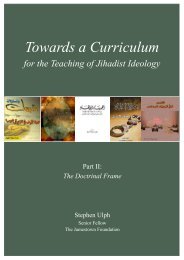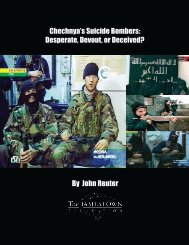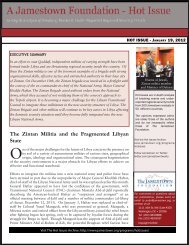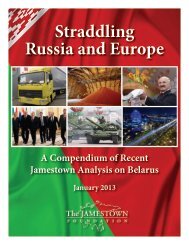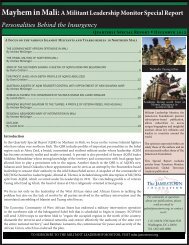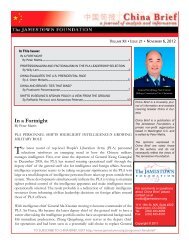Book 1.indb - The Jamestown Foundation
Book 1.indb - The Jamestown Foundation
Book 1.indb - The Jamestown Foundation
You also want an ePaper? Increase the reach of your titles
YUMPU automatically turns print PDFs into web optimized ePapers that Google loves.
<strong>The</strong> Tulip Revolution: Kyrgyzstan One Year After<br />
impose economic sanctions against Kyrgyzstan. Acting President Kurmanbek Bakiyev<br />
has already made a statement supporting Karimov, saying that the bloody events in<br />
Andijan were organized by terrorists. 3 Nonetheless, the Kyrgyz government will likely<br />
face widespread public criticism if the refugees are forced to return to Uzbekistan.<br />
Kyrgyz human rights activists have appealed to the government to allow<br />
the refugees to remain inside Kyrgyzstan for the duration of the crisis in<br />
Uzbekistan. “<strong>The</strong> Kyrgyz government by no means should allow the extradition<br />
of peaceful citizens, including those injured, back to Uzbekistan,” according<br />
to the activists. 4 Several think tanks agree, noting, “Only by showing<br />
kindness and realizing its international responsibility can the Kyrgyz government<br />
confirm its long-term interest in the Kyrgyz-Uzbek friendship.” 5<br />
<strong>The</strong> Andijan and Pakhtaabad massacres have provoked discussions in the<br />
Kyrgyz parliament about the need to improve communications between Kyrgyzstan<br />
and Uzbekistan in order to increase local trade. <strong>The</strong> local bridge rebuilt within<br />
several hours for Uzbek refuges in Karasuu not only helped civilians escape from<br />
Uzbekistan, but also instantly boosted inter-state trade in fruits and vegetables.<br />
After meeting with Uzbek and Kyrgyz citizens in Karasuu, the Kyrgyz Ombudsman<br />
asked parliament to provide all possible means for facilitating trade at border areas:<br />
“This would accord with the hopes of ordinary Kyrgyz and Uzbek citizens”. 6 <strong>The</strong>re<br />
are already thousands of Uzbek and Tajik<br />
seasonal workers in southern Kyrgyzstan.<br />
Kyrgyzstan has a long history accommodating large flows of refugees.<br />
During the civil war in Tajikistan approximately 20,000 Tajiks fled<br />
to Kyrgyzstan. Several thousand refugees from Afghanistan moved to<br />
Kyrgyzstan in the 1980s and 1990s. Many of the Tajik<br />
refugees were repatriated<br />
to Tajikistan after the peace accord was reached between the government<br />
and opposition in 1997. However, it is also evident that many refugees see<br />
Kyrgyzstan as a transit point en route to Russia, Europe and North America.<br />
Popular attitudes toward human-rights abuses in Kyrgyzstan changed following<br />
the Aksy<br />
riots in March 2002, when six civilians were shot dead by law-enforce-<br />
ment agencies. <strong>The</strong> incident provoked a deep and lasting political crisis in the country.<br />
Many local NGOs openly criticized President Askar Akayev’s politics and the<br />
Kyrgyz security structures. Some experts believe that the March Tulip Revolution was<br />
the culmination of public dissatisfaction with the government’s actions in 2002. Yet<br />
no Kyrgyz NGO leaders think that the Tulip Revolution in Kyrgyzstan was the main<br />
reason for the Uzbek uprising. Civil society activists such as Edil Baisalov, president<br />
of the Coalition for Democracy and Civil Society, discount Karimov’s accusations<br />
that residents of southern Kyrgyzstan inspired Uzbeks to revolt against the govern-<br />
ment. Rather, the Karimov<br />
regime’s total suppression of civil society and mass media<br />
led to the devastating clash between impoverished crowds and armed government.<br />
38




